Angiosperms: The Flowering Plants
Angiosperms are a group of plants that produce flowers and seeds enclosed within a fruit. They are the most diverse group of plants on Earth and can be found in a wide range of habitats, from tropical rainforests to arid deserts.
Characteristics of Angiosperms:
- Flowers: Angiosperms are distinguished by their reproductive structures, called flowers, which are responsible for producing seeds.
- Fruits: After fertilization, the ovary of the flower develops into a fruit, which protects and helps disperse the seeds.
- Seeds: The seeds of angiosperms are enclosed within the ovary and provide a protective covering for the developing embryo.
- Vascular Tissue: Angiosperms have well-developed vascular tissue, which allows for the efficient transport of water, nutrients, and sugars throughout the plant.
Classification of Angiosperms:
Angiosperms are divided into two main classes: monocots and dicots.
- Monocots: Plants with one cotyledon (seed leaf), parallel leaf veins, and flower parts in multiples of three.
- Dicots: Plants with two cotyledons, netted leaf veins, and flower parts in multiples of four or five.
Importance of Angiosperms:
Angiosperms play a crucial role in the environment and in human society. They provide food, medicine, and materials for clothing, shelter, and fuel. Additionally, they contribute to the oxygen cycle and provide habitats for a wide variety of organisms.
Study Guide:
- What are the reproductive structures of angiosperms called? Answer: Flowers
- What develops from the ovary of a flower after fertilization? Answer: Fruit
- What type of vascular tissue do angiosperms have? Answer: Well-developed vascular tissue
- How are angiosperms classified? Answer: Into monocots and dicots
- What are the main differences between monocots and dicots? Answer: Monocots have one cotyledon, parallel leaf veins, and flower parts in multiples of three, while dicots have two cotyledons, netted leaf veins, and flower parts in multiples of four or five.
◂Science Worksheets and Study Guides Second Grade. Mammals and birds
Study Guide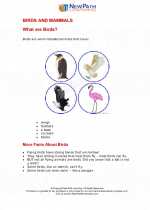 Mammals and birds
Mammals and birds  Activity Lesson
Activity Lesson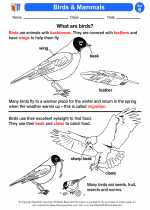 Birds & Mammals
Birds & Mammals  Worksheet/Answer key
Worksheet/Answer key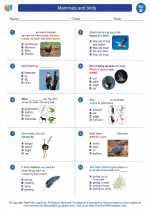 Mammals and birds
Mammals and birds  Worksheet/Answer key
Worksheet/Answer key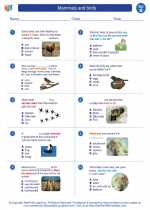 Mammals and birds
Mammals and birds  Worksheet/Answer key
Worksheet/Answer key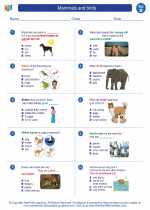 Mammals and birds
Mammals and birds  Worksheet/Answer key
Worksheet/Answer key Mammals and birds
Mammals and birds  Vocabulary/Answer key
Vocabulary/Answer key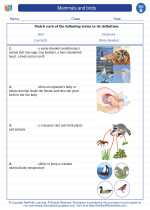 Mammals and birds
Mammals and birds 

 Activity Lesson
Activity Lesson
 Worksheet/Answer key
Worksheet/Answer key
 Worksheet/Answer key
Worksheet/Answer key
 Worksheet/Answer key
Worksheet/Answer key
 Worksheet/Answer key
Worksheet/Answer key
 Vocabulary/Answer key
Vocabulary/Answer key

The resources above cover the following skills:
LIFE SCIENCE (NGSS)
Biological Evolution: Unity and Diversity
Students who demonstrate understanding can:
Make observations of plants and animals to compare the diversity of life in different habitats[Clarification Statement: Emphasis is on the diversity of living things in each of a variety of different habitats.] [Assessment Boundary: Assessment does not include specific animal and plant names in specific habitats.]